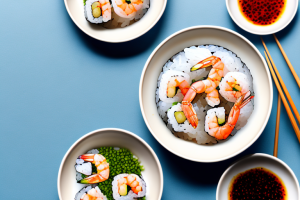How to steam sushi rice with spicy tuna
9 min read
A bowl of sushi rice with spicy tuna on top
Sushi is one of the most beloved Japanese dishes, and it’s always ideal to make it at home. This way, you get to customise your own ingredients and techniques to create a sushi roll that is perfect for your tastes. In this article, we’ll guide you on how to steam sushi rice with spicy tuna, a popular and delicious sushi roll that brings a fiery kick to an already delicious meal.
The perfect sushi rice: a step-by-step guide
Sushi rice is an essential component in any sushi roll, and the preparation of it is key to a successful roll. To achieve the perfect sushi rice, first, make sure that you rinse the rice well to remove any excess starch. This will prevent the rice grains from sticking together during the cooking process. After rinsing, place the rice in a pot and add enough water to cover it by about two fingers’ width. Bring the water to a boil, then reduce the heat to low, and let the rice cook for about 17 minutes while keeping the lid on the pot.
Afterward, turn off the heat and let the rice sit with the lid for another 10 minutes to absorb steam and cook fully. You can prepare the seasoning for the rice by mixing rice vinegar, sugar and salt in a saucepan, heat it on low until the sugar and salt dissolve, and then pour it over the cooked rice. Stir the rice gently, so that the seasoning coats all the grains but doesn’t smash them.
It’s important to note that the type of rice you use can also affect the outcome of your sushi rice. Short-grain Japanese rice is the most commonly used type of rice for sushi, as it has a sticky texture that holds the roll together. However, if you can’t find Japanese rice, you can also use other types of short-grain rice, such as Arborio or Calrose.
Another tip for achieving perfect sushi rice is to use a wooden spoon or paddle when mixing the seasoning into the rice. This will prevent the rice from becoming too compacted and sticky, which can make it difficult to work with when rolling your sushi. Additionally, it’s important to let the rice cool to room temperature before using it in your sushi rolls, as warm rice can cause the nori (seaweed) to become soggy and tear.
What is spicy tuna and how to prepare it for sushi
Spicy tuna is a mixture of chopped or ground raw tuna and a spicy mayo sauce. To prepare it, first, mix together mayonnaise, Sriracha sauce, and a dash of sesame oil. Make sure that all the components are well combined, and then add the chopped or ground raw tuna into the mixture. Mix the ingredients until the tuna is well coated with the spicy mayo sauce.
Spicy tuna is a popular ingredient in sushi rolls and can also be used as a topping for rice bowls or salads. It adds a kick of flavor and heat to any dish. When making spicy tuna for sushi, it’s important to use fresh, high-quality tuna to ensure the best taste and texture.
If you prefer a milder spice level, you can adjust the amount of Sriracha sauce in the recipe. You can also experiment with adding other ingredients such as avocado, cucumber, or scallions to the spicy tuna mixture for added flavor and texture.
The essential tools you need for steaming sushi rice
To steam sushi rice at home, you don’t really need much equipment. A pot with a lid to cook the rice, a wooden spoon or spatula to stir the rice, and a good quality rice cooker are the only essential tools to prepare the perfect sushi rice. However, for beginners, a rice paddle can be helpful to prevent rice from sticking to fingers.
Another important tool to consider is a rice washing bowl. This is a specially designed bowl that allows you to rinse the rice thoroughly before cooking, removing excess starch and impurities. It’s an important step in achieving the perfect texture and flavor for your sushi rice. Additionally, a bamboo mat can be useful for rolling sushi, but it’s not essential for steaming the rice.
Common mistakes to avoid when steaming sushi rice
One of the most common mistakes when steaming sushi rice is to use too much water, which leads to soggy rice. Another mistake is to let the rice boil too rapidly, which can lead to undercooked rice or unevenly cooked rice grains. It’s also important not to lift the lid too often during cooking, as the steam will escape, affecting the cooking process.
Another mistake to avoid when steaming sushi rice is to not rinse the rice thoroughly before cooking. Rinsing the rice helps to remove excess starch and debris, resulting in fluffier and more evenly cooked rice. Additionally, it’s important to use the correct ratio of rice to water, as using too little water can result in dry and hard rice, while using too much water can result in mushy and overcooked rice.
Another tip to keep in mind when steaming sushi rice is to let the rice rest for a few minutes after cooking. This allows the rice to absorb any remaining moisture and become more tender. It’s also important to use a high-quality rice cooker or pot with a tight-fitting lid to ensure even cooking and prevent steam from escaping.
Tips for seasoning your sushi rice with vinegar and sugar
The secret to a perfectly seasoned sushi rice is the balance between vinegar, sugar, and salt. For a satisfying taste, the vinegar should not be too overpowering, but not too light either. Slowly add the rice vinegar to the pot and consistently taste to prevent overseasoning. To balance the tartness of vinegar, add an exact ratio of granulated sugar and salt. In addition to sushi rice seasoning, seasoning the rice with furikake seaweed flakes, sesame seeds, or other Japanese condiments is an excellent way to add more flavour.
Another important tip for seasoning your sushi rice is to use high-quality ingredients. The type of rice, vinegar, sugar, and salt you use can greatly affect the taste of your sushi rice. It is recommended to use short-grain Japanese rice, rice vinegar, and high-quality granulated sugar and sea salt. Additionally, using a wooden spoon or paddle to mix the rice and seasoning can prevent the rice from becoming too sticky or mushy. With these tips, you can create delicious and perfectly seasoned sushi rice for your homemade sushi rolls.
How to make a spicy mayo sauce to complement your spicy tuna roll
The spicy mayo sauce is the perfect complement to the spicy tuna roll, and it’s easy to make. Simply mix mayonnaise, Sriracha sauce, and a dash of sesame oil in a bowl and stir well until the ingredients are well combined. Adjust the spiciness according to preferences by using more or less Sriracha sauce. A little sprinkle of green onions or shichimi togarashi pepper spice mix can be a great addition too.
Another great addition to the spicy mayo sauce is a squeeze of fresh lime juice. This adds a tangy and refreshing flavor that balances out the spiciness of the sauce. You can also experiment with adding other spices or herbs, such as garlic powder or cilantro, to give the sauce a unique twist.
If you’re looking for a healthier alternative to mayonnaise, you can substitute it with Greek yogurt or avocado. Both options provide a creamy texture and a healthier fat source. You can also use low-fat mayonnaise to reduce the calorie content of the sauce.
A beginner’s guide to rolling sushi: step-by-step instructions
Rolling sushi can seem intimidating for beginners, but it’s not as complicated as it seems. Before rolling the sushi, place a sheet of nori on a bamboo rolling mat with the shiny part facing downwards. Dampen your fingers with a bit of water or vinegar to prevent rice from sticking to it and gently spread the cooked sushi rice over the nori sheet with a wooden spoon, leaving a small gap at the top of the nori sheet uncovered.
Lay the spicy tuna and any other desired ingredients over rice and the center of the nori sheet. The ingredients should go on the side closest to you. Firmly hold the bamboo mat and roll the nori sheet tightly away from your body, pressing the sushi roll gently to keep the shape even. When the roll is complete, use a sharp knife poised in a cold water bath to slice the sushi roll with a swift and steady hand. Serve and enjoy!
It’s important to note that the quality of the ingredients used in sushi can greatly affect the taste and overall experience. When selecting fish, make sure it is fresh and of high quality. It’s also important to use the correct type of rice, such as short-grain sushi rice, and to properly season it with vinegar, sugar, and salt. Additionally, using a good quality soy sauce and wasabi can enhance the flavor of the sushi. By using high-quality ingredients, you can elevate your sushi-making skills and create a delicious and authentic sushi experience.
Creative ways to present and garnish your spicy tuna roll
There are many creative ways to present and garnish your spicy tuna rolls. You can choose to serve the rolls sliced or as a whole. Some great presentation techniques include topping the spicy tuna roll with black or white sesame seeds, pickled ginger, and some slices of avocado. You can also add an extra pop of spice by sprinkling a little more shichimi togarashi spice mix over the top.
Pairing suggestions: the best drinks and sides for your sushi feast
When it comes to pairing drinks with sushi, you have many options. For those who prefer beer, a crisp and light lager beer can be a great choice. However, sake is considered the traditional and perfect pairing for sushi. A cold glass of sake enhances the umami of both the sushi rice and the spicy tuna. For side dishes, you can consider edamame, crunchy tempura veggies, or miso soup.
The health benefits of eating sushi and how to make it even healthier
Sushi can be a very healthy meal option. By choosing fresh and nutritious ingredients like salmon, avocado, and tuna, sushi can be an excellent source of omega-3 fatty acids, vitamins, and minerals. You can make sushi even healthier by swapping out the white rice for brown rice and using low-sodium soy sauce.
How to store leftover sushi and enjoy it later
Leftover sushi can be a tasty and filling meal option for the next day. To store leftover sushi, wrap the rolls tightly with plastic wrap and refrigerate. To enjoy it later, let the sushi rolls sit at room temperature for about 10-15 minutes before consuming, as this will help the rice regain its softness and texture.
Troubleshooting: common issues that may arise when making sushi at home and how to fix them
Some common issues that might arise when making sushi include over-seasoned or under-seasoned rice, or fish that is too thick or not cut properly. To remedy over-seasoned rice, you can add some water and mix well. To fix under-seasoned rice, sprinkle some more seasoning mixture over the rice and mix it well. If the fish is too thick, try slicing it thinner, and if it’s not cut properly, use a sharp knife and be sure to angle each slice to give it a more refined appearance.
With these tips, you can become a sushi-making pro in no time and impress all your friends and family at the dinner table with your delicious spicy tuna rolls. By steaming the sushi rice correctly, preparing the spicy tuna, and rolling the sushi with precision, you’ll get to enjoy the perfect sushi meal that you crave.


